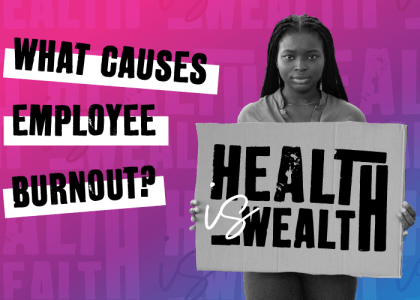What causes employee burnout?

Burnout is everywhere in the modern office. What are the causes of burnout at work, how can you spot the signs, and what are the long-term solutions to protect your employees?
Defining Employee Burnout
Firstly, let’s take a second to figure out what is meant by burnout.
Some people use the terms burnout and stress synonymously, but they’re distinct. Burnout is what happens when someone is stressed for a prolonged period of time and is classed as an occupational hazard.
Think of it like running a petrol car. You can drive around when the fuel light is on, and it’ll keep going for a bit longer. But once your gauge hits zero, you can start doing real damage to the internal components of the vehicle.
Once you’ve reached this point mentally, it can be incredibly difficult to pull yourself out of it without making huge changes.
Recognising Signs of Employee Burnout
As with any mental health issue, one of the most common and yet easy to miss signs is a change in behaviour. Managers have a particularly important role to notice and flag this up, but by educating the entire department about these signs, those
If someone seems like:
- They’ve lost any motivation for work
- They take criticism incredibly personally
- They’re worried about failure, but seem to think failure is inevitable
- They’re less efficient than usual
- They’re frequently tired.
You should keep an eye on them. Alone, these things may not signal burnout, but if this is a departure from how someone usually acts, that could be a warning sign.
The big problem with burnout is that it compounds on itself. It impacts your physical health and makes it harder to sleep, which can often lead to you feeling more run down and stressed. Likewise, it makes it harder to engage with work, which can lead to work piling up, more stress and even more burnout.
In the long-term, burned-out employees take more time off, work less effectively, and can even wind up quitting very suddenly. This can have a negative impact on your other employees as their workloads increase to balance things out.
Key Causes of Employee Burnout
So what is the root cause of burnout? It’s hard to pin down, and what causes one person a lot of stress may be a situation where another person thrives.
Burnout at work isn’t the only risk factor. People may have some personal factors that make them more susceptible to it. For example, people with perfectionist traits may find themselves struggling. People with financial obligations (such as dependents) and other external stressors are also at risk.
This is not to say that these factors make burnout their problem. Workplace factors are the single biggest contributor to burnout symptoms, so implementing a strategy that enables a strong work-life balance is vital.
Workplace factors can include:
- Excessive workload with too tight deadlines
- High levels of pressure
- Reduced agency
- Insufficient resources
- Lack of recognition
Again, these factors being at play on their own won’t necessarily cause burnout, but any of them can be a major contributor.
Strategies to Prevent Employee Burnout
We can’t ever promise to completely remove stress from the workday. What we can do is ensure that the stressful times aren’t considered standard and put procedures in place for employees when things do start to get on top of them.
Promoting employee wellness is vital. This can include a range of non-salaried benefits like food or gym vouchers, as well as providing more relaxing environments to work in if they need a change of scenery.
However, wellness schemes will ring hollow if they don’t come back up with robust internal policies and managerial support. A healthy lifestyle programme isn’t helpful if you’re stuck handling the workload of three people!
As a result, it’s important to utilise talent and workforce management tools to ensure you have adequate coverage. Encourage managers to use check-ins with employees and train them up on recognising the signs of burnout. This will help them take some of the workload off.
Mental health first aiders can also help with any emerging crisis- providing a safe, judgment free space that falls outside of the typical line manager relationship for employees to get support.
Remember, you need to put into work to help employees overcome some of the barriers that have formed around seeking mental health support. Did you know that 0% of employees who come forward with a mental health concern (which can include burnout) were subject to disciplinary procedures, demotion, or dismissal?



